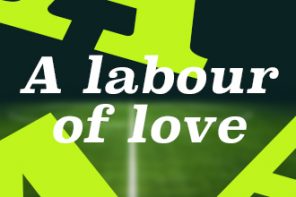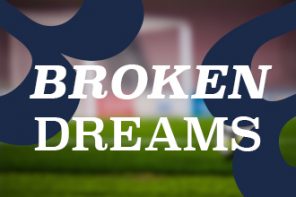With the most famous clash in Dutch football approaching, the sword of Damocles, as ever, hangs precariously over proceedings in De Klassieker. When Ajax and Feyenoord face each other, sparks usually fly. It has been forever thus. Even the very first game between the sides, in 1919, ended in controversy. Ajax won 3-2 with a dubious winner. Feyenoord appealed and the game was declared a 2-2 draw.
Amsterdam and Rotterdam are only 43 miles apart yet there’s a cavernous divide between the two cities. Rotterdam is a port city – the second biggest in the world – a labour stronghold, austere and working class. Amsterdam is regarded as cosmopolitan, philosophical, wealthier, a cultured, free-wheeling partying city. The Dutch have a saying: “Amsterdam to party, Den Haag to live and Rotterdam to work”.
De Klassieker has thrown up some explosive contests over the years, including rioting, and in 1997 The Battle of Beverwijk, which saw a man murdered when hooligans clashed. But few seasons come close to 1983/84 when Feyenoord and Ajax would face each other four times – twice in the league, a cup tie and replay. There was the greatest plot twist for this season’s games; Ajax legend Johan Cruyff was playing for bitter rivals, Feyenoord.
Cruyff signing for Feyenoord is like Messi leaving Barca in a huff and joining Real Madrid and winning the double. Or maybe Mo Salah, after a long, successful career with Liverpool, expecting a final season, told he’s too old, goes on to sign for Manchester United for his final season, dragging them to a league and cup double, and being named player of the year.
Why all the fuss? Dramatic scenes often need context. Hendrik Johannes Cruijff was an Ajax fan, his dad was a fan; Johan had Ajax blood coursing through his veins. Ajax was part of his DNA. He was born in Betondorp, close to Ajax’s old De Meer Stadion. He was the club’s most famous son. When Ajax supporters claimed Cruyff was one of their own – they meant it. He delivered fruit and veg to the ground when he was five. He signed for Ajax on his 10th birthday, starring each year and when tested against players two or three years older, still shone.
As a teenager, he helped ground-staff aerate the pitch, he cleaned toilets and dressing rooms. He scored on his debut for the first team, aged 17, and would go on to win the European Cup three years in a row. Feyenoord fans hated Cruyff.
Cruyff had retired in 1978, aged 31, tired of training, travelling and playing. Both he and his wife befriended a charming Barcelona neighbour who robbed them of almost $6m ($23m today). They were conned, assumed they had bought old properties and businesses, including a pig farm. They hadn’t. Their money was gone. Soon, his father-in-law and agent, Cor Coster had him back playing in the lucrative NASL.
The optimism in the US was a welcome change from the cynicism of Europe. Cruyff was MVP in his season at LA Aztecs. Next, he joined the Washington Diplomats, where he hung out with the Kennedys but the soccer standard was poor.
He returned to Europe, with a brief spell at Levante (only 10 games), due to injury and wage issues before re-joining Ajax for a second spell in 1981/82. As part of the contract, Cor Coster negotiated a gate deal, which saw anything over the average gate halved between his client and the club.
Cruyff’s first game in his second spell for Ajax began against Haarlem. Twenty-one minutes in and Lerby let the ball roll to Cruyff who found space and expertly lobbed the keeper. Then he celebrated like he’d never been away. Cruyff continued with incredible performances and with their club legend at the helm, fans showed up. Everyone was happy with the arrangement. By the end of this 1981/82 season, Ajax won the Eredivisie. In 1982/83 Ajax won both the league and cup.
During that season I saw Cruyff play, when Ajax faced Celtic in September 1982, in the European Cup. I had to confirm that Cruyff was made of flesh and dwelt among us. It felt like witnessing a Beatle, aged 35, he bossed it. He was in control, passing and moving and running and shouting and guiding and pointing and twisting and turning. He encouraged, applauded, sprinted and darted. There was a mathematical fluidity to his game. After witnessing Cruyff play, it changed how you watched football.
It is easy to understand Cruyff’s disbelief when his beloved side didn’t offer a valedictory season after all he had given. Ajax said, at 36, he was too old, had put on weight and instead offered a standard player contract, hoping Cruyff would feel insulted and leave. He was… and did.
According to Cruyff, the Ajax directors had grossly underestimated his box office appeal and were furious at his cut from the gate deal. Feyenoord were keen and told Coster they were willing to match the gate deal and better still, their stadium held 60,000. So, Cruyff headed to Rotterdam, signing for De Trots van Zuid (The Pride of the South), playing alongside the emerging Ruud Gullit, the in-form striker, Peter Houtman (the current stadium announcer at Du Kuip Stadion) and the powerful, attacking midfielder, André Hoekstra. Here, he galvanised a workman-like Feyenoord to a historic double and was voted player of the year.
Leading into the first De Klassieker, Feyenoord were confident. They had won six and drawn one of their opening games. Thijs Libregts may have been Feyenoord’s manager but Cruyff was the boss. Ruud Gullit was blunt when he said: “It was not the manager but Cruyff who dictated tactics and positions. My place in his ideal Feyenoord line-up was as a pure outside-right but Cruyff’s will was law.” Ruud Gullit starred throughout this season but it was Ajax’s Marco van Basten and Jesper Olsen who were unplayable in this first game.
Van Basten scored a hat-trick, Olsen scored twice, Koeman added from the spot, Cornelius Ignatius Maria Molenaar and Peter Boeve joined in the fun. Ajax deployed a devastating, textbook counter-attacking approach. Despite pulling back to 3-2 in the game with goals from Gullit and Houtman, Feyenoord could not handle Ajax’s intensity, slick movement and accurate passing. Feyenoord looked dazed and shell shocked and defended poorly. It ended 8-2, with 10 goals and the obligatory crowd trouble.
In the hands of any other footballer, a crushing humiliation from your greatest rivals would make you want to crawl under a stone. Not Cruyff. He could see the problem and had the solution. Cruyff not only told teammates they would win the title but to reaffirm the point, he appeared on the Dutch version of Match of the Day to tell the nation. At the time, it was considered a Kevin Keegan ‘I’d love it’ moment in Dutch football, a public breakdown. After the 8-2 trouncing he said: “It was only two points, the prizes are given out at the end of the competition, at the end of the 34 games, just wait. You’ll see.”
When Ruud Gullit speaks now about Cruyff and this season, it’s with a mix of deference and awe. “He was a leader and innovator,” said Gullit. “I played with him for a year at Feyenoord, he came to us, at 36. He came to Feyenoord for revenge after they treated him badly at Ajax, his own team, and said OK I’m going to show you.” Cruyff tweaked the system, the players followed him. The training was intense. Gullit continues: “In training, I couldn’t get the ball off him, at 36. He was so bony and it hurt when you tackled him. He would hit you with an elbow. He was so quick at the first five yards.”
Cruyff was a fierce genius, one who brought a different level of insight, the detail was surgical, the process at times, a brutal neurosis, a beautiful obsession. The correct start in the right position could open up the game. Pep Guardiola, said: “In Spain, we call it the efecto mariposa [the butterfly effect]. For him, one good pass at the beginning could create absolutely everything.”
For Cruyff it was obvious. The fan’s favourite, the left-winger Pierre Vermeulen was replaced with the energetic Stanley Brard. Cruyff liked his attitude, he was on a part-time contract with Feyenoord, only trained twice a week but was a PE teacher and super fit. It’s commonplace now but the left-back became a left-winger, Brard played higher up the park, stopping the supply from the opposition’s full-back. Along with experienced attacking left-back Ben Wijnstekers, both powered up and down the left, Cruyff could get further up the park, do more damage and less running back. Stan and Ben could retreat when Feyenoord lost possession. Simple but effective.
The side was now ready, a fluid 4-3-3, and it was working. After the 8-2 defeat to Ajax, Feyenoord went on an unbeaten league run of 15 games but before their next league meeting against their Amsterdam rivals, Feyenoord lost to Groningen, the only game Cruyff did not play.
For the second De Klassieker, the atmosphere in De Kuip was electric, with 58,000 eager fans showing up – and they weren’t disappointed. Feyenoord trounced Ajax 4-1. Feyenoord’s opener was a glorious Ruud Gullit free-kick, regarded as one of the best scored in the Eredivisie. From 36 yards out, he placed a shot, with the inside of his foot, into the top corner. With wonderful technique, Gullit hit a free-kick like a penalty, the power coming from the speed of his run-up. Cruyff joined in two minutes later, when Gullit received a short corner and crossed, Cruyff’s header was parried by the keeper before he reacted with a high left-foot shot from close range. Cruyff celebrated with his distinctive traditional jump and clenched fist, used throughout his career. This was a dig at the Ajax board. Too old? Too fat? Too slow? Really? His elation was that of a player telling his old employers to stick their standard player contract where the sun never shines.
Jan Mölby pulled one back early in the second half but Feyenoord were imperious. Gullit was instrumental in the third, breaking into acres of space, striding into the box, he cut back for Hoekstra to score his 14th goal of the season. The fourth came in the 80th minute, Houtman fed in Henk Duut with a reverse pass. He remained cool, passing a right-footed shot through the keeper’s legs. After this game, Feyenoord remained unbeaten in the league until the end of the season, winning a historic title.
Between both league games, Feyenoord and Ajax met in the KNVB Cup. The first game in Amsterdam ended 2-2. Houtman opened the scoring for Feyenoord, Koeman missed a penalty, Rijkaard equalised with a superb 30-yard right-footed shot past the helpless Hiele. Cruyff set in motion the move which led to the second Feyenoord goal. Collecting in the right-back position, and, far too easily, for someone aged 36, found another gear, left his opponent behind and passing with the outside of his left foot, found Hoekstra, who played in Gullit to finish. Ajax equalised in the 68th minute after Marco van Basten rose to head home from a Felix Gasselich corner. During this game, as Olsen attacked, Ajax fans threw a firework at Feyenoord’s keeper, Joop Hiele. The force and impact of the explosion hurt him. Unbelievably, the referee and players ignored it and played on. If it happened today an ambulance, surgeon and priest would be called.
The tie would go back to De Kuip for a replay. Feyenoord won 2-1 in extra time. They went to lift the KNVB Cup.
Cruyff’s prediction had proven accurate. He drove his side on to a league and cup double and was named player of the year. Dutch football hadn’t seen a year like it. “It was only two points, the prizes are given out at the end of the competition at the end of the 34 games, just wait. You’ll see.”
Buy Fierce Genius: Cruyff’s Year at Feyenoord by Andy Bollen (Pitch Publishing), on sale now






